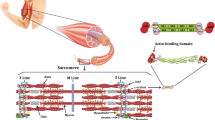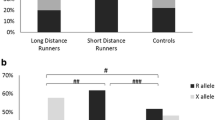Abstract
Purpose
Exercise-induced muscle damage has been identified as one of the main causes of the progressive decrease in running and muscular performance in marathoners. The aim of this investigation was to determine the influence of the ACTN3 genotype on exercise-induced muscle damage produced during a marathon.
Methods
Seventy-one experienced runners competed in a marathon race. Before and after the race, a sample of venous blood was obtained and maximal voluntary leg muscle power was measured during a countermovement jump. In the blood samples, the ACTN3 genotype (R577X) and the changes in serum creatine kinase and myoglobin concentrations were measured. Data from RX heterozygotes and XX mutant homozygotes were grouped as X allele carriers and compared to RR homozygotes.
Results
At the end of the race, X allele carriers presented higher serum myoglobin (774 ± 852 vs 487 ± 367 U L−1; P = 0.02) and creatine kinase concentrations (508 ± 346 vs 359 ± 170 ng mL−1; P = 0.04) than RR homozygotes. Pre-to-post-race maximal voluntary leg muscle power reduction was more pronounced in X allele carriers than RR homozygotes (−34.4 ± 16.1 vs −27.3 ± 15.4%; P = 0.05). X allele carriers self-reported higher levels of lower limb muscle pain (7 ± 2 vs 6 ± 2 cm; P = 0.02) than RR homozygotes at the end of the race.
Conclusions
In comparison to RR homozygotes, X allele carriers for the R577X polymorphism of the ACTN3 gene presented higher values for typical markers of exercise-induced muscle damage during a competitive marathon. Thus, the absence of a functional α-actinin-3 produced by the X allele might induce higher levels of muscle breakdown during prolonged running events.


Similar content being viewed by others
Abbreviations
- Δ:
-
Percentage of difference
- ACTN2:
-
α-Actinin-2 gene
- ACTN3:
-
α-Actinin-3 gene
- A.U.:
-
Arbitrary units
- DNA:
-
Deoxyribonucleic acid
- ES:
-
Effect size
- PCR:
-
Polymerase chain reaction
- SNP:
-
Single-nucleotide polymorphism
References
Abian P, Coso JD, Salinero JJ, Gallo-Salazar C, Areces F, Ruiz-Vicente D, Lara B, Soriano L, Munoz V, Lorenzo-Capella I, Abian-Vicen J (2015) Muscle damage produced during a simulated badminton match in competitive male players. Res Sports Med:1–14. doi:10.1080/15438627.2015.1076416
Areces F, Salinero JJ, Abian-Vicen J, Gonzalez-Millan C, Gallo-Salazar C, Ruiz-Vicente D, Lara B, Del Coso J (2014) A 7-day oral supplementation with branched-chain amino acids was ineffective to prevent muscle damage during a marathon. Amino Acids 46(5):1169–1176. doi:10.1007/s00726-014-1677-3
Areces F, Salinero JJ, Abian-Vicen J, Gonzalez-Millan C, Ruiz-Vicente D, Lara B, Lledo M, Del Coso J (2015) The use of compression stockings during a marathon competition to reduce exercise-induced muscle damage: are they really useful? J Orthop Sports Phys Ther 45(6):462–470. doi:10.2519/jospt.2015.5863
Baxter RE, Moore JH (2003) Diagnosis and treatment of acute exertional rhabdomyolysis. J Orthop Sports Phys Ther 33(3):104–108. doi:10.2519/jospt.2003.33.3.104
Borg GA (1982) Psychophysical bases of perceived exertion. Med Sci Sports Exerc 14(5):377–381
Chatzinikolaou A, Draganidis D, Avloniti A, Karipidis A, Jamurtas AZ, Skevaki CL, Tsoukas D, Sovatzidis A, Theodorou A, Kambas A, Papassotiriou I, Taxildaris K, Fatouros I (2014) The microcycle of inflammation and performance changes after a basketball match. J Sports Sci 32(9):870–882. doi:10.1080/02640414.2013.865251
Clarkson PM (2007) Exertional rhabdomyolysis and acute renal failure in marathon runners. Sports Med (Auckland, NZ) 37(4–5):361–363
Clarkson PM, Hubal MJ (2002) Exercise-induced muscle damage in humans. Am J Phys Med Rehabil 81(11 Suppl):S52–S69. doi:10.1097/01.PHM.0000029772.45258.43
Clarkson PM, Hoffman EP, Zambraski E, Gordish-Dressman H, Kearns A, Hubal M, Harmon B, Devaney JM (2005) ACTN3 and MLCK genotype associations with exertional muscle damage. J Appl Physiol (1985) 99 (2):564–569. doi:10.1152/japplphysiol.00130.2005
Cohen J (1988) Statistical power analysis for the behavioral sciences. Lawrence Erlbaum Associates, Hillsdale
Cuisinier C, Ward RJ, Francaux M, Sturbois X, de Witte P (2001) Changes in plasma and urinary taurine and amino acids in runners immediately and 24h after a marathon. Amino Acids 20(1):13–23
Del Coso J, Gonzalez-Millan C, Salinero JJ, Abian-Vicen J, Soriano L, Garde S, Perez-Gonzalez B (2012) Muscle damage and its relationship with muscle fatigue during a half-iron triathlon. PloS one 7(8):e43280. doi:10.1371/journal.pone.0043280
Del Coso J, Fernandez de Velasco D, Abian-Vicen J, Salinero JJ, Gonzalez-Millan C, Areces F, Ruiz D, Gallo C, Calleja-Gonzalez J, Perez-Gonzalez B (2013a) Running pace decrease during a marathon is positively related to blood markers of muscle damage. PloS one 8(2):e57602. doi:10.1371/journal.pone.0057602
Del Coso J, Salinero JJ, Abian-Vicen J, Gonzalez-Millan C, Garde S, Vega P, Perez-Gonzalez B (2013b) Influence of body mass loss and myoglobinuria on the development of muscle fatigue after a marathon in a warm environment. Appl Physiol Nutr Metab 38(3):286–291. doi:10.1139/apnm-2012-0241
Del Coso J, Salinero JJ, Lara B, Gallo-Salazar C, Areces F, Puente C, Herrero D (2016) ACTN3 X-allele carriers had greater levels of muscle damage during a half-ironman. Eur J Appl Physiol. doi:10.1007/s00421-016-3507-7
Deuster PA, Contreras-Sesvold CL, O’Connor FG, Campbell WW, Kenney K, Capacchione JF, Landau ME, Muldoon SM, Rushing EJ, Heled Y (2013) Genetic polymorphisms associated with exertional rhabdomyolysis. Eur J Appl Physiol 113(8):1997–2004. doi:10.1007/s00421-013-2622-y
Eynon N, Ruiz JR, Oliveira J, Duarte JA, Birk R, Lucia A (2011) Genes and elite athletes: a roadmap for future research. J Physiol 589(Pt 13):3063–3070. doi:10.1113/jphysiol.2011.207035
Eynon N, Hanson ED, Lucia A, Houweling PJ, Garton F, North KN, Bishop DJ (2013) Genes for elite power and sprint performance: ACTN3 leads the way. Sports Med (Auckland, NZ) 43(9):803–817. doi:10.1007/s40279-013-0059-4
Friden J, Lieber RL (1992) Structural and mechanical basis of exercise-induced muscle injury. Med Sci Sports Exerc 24(5):521–530
Head SI, Chan S, Houweling PJ, Quinlan KG, Murphy R, Wagner S, Friedrich O, North KN (2015) Altered Ca2+ kinetics associated with alpha-actinin-3 deficiency may explain positive selection for ACTN3 null allele in human evolution. PLoS Genet 11(2):e1004862. doi:10.1371/journal.pgen.1004862
Ivarsson N, Westerblad H (2015) alpha-Actinin-3: why gene loss is an evolutionary gain. PLoS Genet 11(1):e1004908. doi:10.1371/journal.pgen.1004908
Ma F, Yang Y, Li X, Zhou F, Gao C, Li M, Gao L (2013) The association of sport performance with ACE and ACTN3 genetic polymorphisms: a systematic review and meta-analysis. PloS one 8(1):e54685. doi:10.1371/journal.pone.0054685
North K (2008) Why is alpha-actinin-3 deficiency so common in the general population? The evolution of athletic performance. Twin Res Hum Genet 11(4):384–394. doi:10.1375/twin.11.4.384
Oxendale CL, Twist C, Daniels M, Highton J (2015) The Relationship Between Match-Play Characteristics of Elite Rugby League and Indirect Markers of Muscle Damage. Int J Sports Physiol Perform. doi:10.1123/ijspp.2015-0406
Pimenta EM, Coelho DB, Cruz IR, Morandi RF, Veneroso CE, de Azambuja Pussieldi G, Carvalho MR, Silami-Garcia E, De Paz Fernandez JA (2012) The ACTN3 genotype in soccer players in response to acute eccentric training. Eur J Appl Physiol 112(4):1495–1503. doi:10.1007/s00421-011-2109-7
Portenoy R, Tanner R (1996) Visual analog scale and verbal pain intensity scale: from pain management: theory and practice. Oxford University Press, New York
Ruiz JR, Fernandez del Valle M, Verde Z, Diez-Vega I, Santiago C, Yvert T, Rodriguez-Romo G, Gomez-Gallego F, Molina JJ, Lucia A (2011) ACTN3 R577X polymorphism does not influence explosive leg muscle power in elite volleyball players. Scand J Med Sci Sports 21(6):e34–e41. doi:10.1111/j.1600-0838.2010.01134.x
Santiago C, Rodriguez-Romo G, Gomez-Gallego F, Gonzalez-Freire M, Yvert T, Verde Z, Naclerio F, Altmae S, Esteve-Lanao J, Ruiz JR, Lucia A (2010) Is there an association between ACTN3 R577X polymorphism and muscle power phenotypes in young, non-athletic adults? Scand J Med Sci Sports 20(5):771–778. doi:10.1111/j.1600-0838.2009.01017.x
Sayers SP, Clarkson PM, Rouzier PA, Kamen G (1999) Adverse events associated with eccentric exercise protocols: six case studies. Med Sci Sports Exerc 31(12):1697–1702
Skiba PF, Jones AM (2011) Implications of the critical speed and slow component of Vo2 for the 2-hour marathon. J Appl Physiol (1985) 110 (1):280; (discussion 294)
Thorpe R, Sunderland C (2012) Muscle damage, endocrine, and immune marker response to a soccer match. J Strength Cond Res 26(10):2783–2790. doi:10.1519/JSC.0b013e318241e174
Venckunas T, Skurvydas A, Brazaitis M, Kamandulis S, Snieckus A, Moran CN (2012) Human alpha-actinin-3 genotype association with exercise-induced muscle damage and the repeated-bout effect. Appl Physiol Nutr Metab 37(6):1038–1046. doi:10.1139/h2012-087
Vincent B, De Bock K, Ramaekers M, Van den Eede E, Van Leemputte M, Hespel P, Thomis MA (2007) ACTN3 (R577X) genotype is associated with fiber type distribution. Physiol Genomics 32(1):58–63. doi:10.1152/physiolgenomics.00173.2007
Vincent B, Windelinckx A, Nielens H, Ramaekers M, Van Leemputte M, Hespel P, Thomis MA (2010) Protective role of alpha-actinin-3 in the response to an acute eccentric exercise bout. J Appl Physiol (1985) 109 (2):564–573. doi:10.1152/japplphysiol.01007.2009
Yang N, MacArthur DG, Gulbin JP, Hahn AG, Beggs AH, Easteal S, North K (2003) ACTN3 genotype is associated with human elite athletic performance. Am J Hum Genet 73(3):627–631. doi:10.1086/377590
Acknowledgements
The authors wish to thank the participants in this study for their invaluable contribution. In addition, we are very grateful to the Organization of Rock ‘n’ Roll Madrid Marathon and ½ for their help in setting the investigation areas at the start and finish lines.
Author information
Authors and Affiliations
Corresponding author
Ethics declarations
Conflict of interest
The authors declare that they have no conflict of interest derived from the outcomes of this study.
Financial support
The study was part of the DAMUS project supported by a Grant-in-aid from the Vice-Rectorate of Research and Science, at the Camilo Jose Cela University.
Ethical approval
All procedures performed in studies involving human participants were in accordance with the ethical standards of the institutional and/or national research committee and with the 1964 Helsinki declaration and its later amendments or comparable ethical standards.
Additional information
Communicated by Fabio Fischetti.
Rights and permissions
About this article
Cite this article
Del Coso, J., Valero, M., Salinero, J.J. et al. ACTN3 genotype influences exercise-induced muscle damage during a marathon competition. Eur J Appl Physiol 117, 409–416 (2017). https://doi.org/10.1007/s00421-017-3542-z
Received:
Accepted:
Published:
Issue Date:
DOI: https://doi.org/10.1007/s00421-017-3542-z




